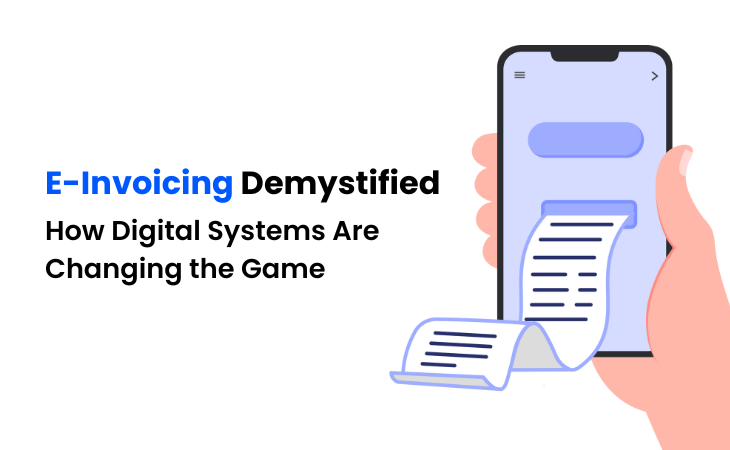
In the era of digitalization, the Indian government’s push for a paperless tax ecosystem has significantly impacted businesses, particularly in the realm of GST (Goods and Services Tax) compliance. One key initiative in this direction is the introduction of e-invoicing, a revolutionary step that transforms the traditional paper-based invoicing system into a streamlined, digital powerhouse. This comprehensive guide delves into the intricacies of e-invoicing under GST, offering valuable insights for businesses of all sizes to navigate this new landscape smoothly.
Unveiling the Power of E-invoicing:
E-invoicing, or electronic invoicing, refers to the process of issuing and receiving invoices electronically in a standard format prescribed by the government. These invoices are authenticated by a designated authority, the Invoice Registration Portal (IRP), which generates a unique Identification Reference Number (IRN) for each invoice. This IRN acts as proof of invoice generation, aids in faster tax return filing, and helps prevent tax evasion.
Who Needs to Embrace E-invoicing?
The applicability of e-invoicing depends on the aggregate turnover of a business in the preceding financial year. As of April 1, 2024, all businesses registered under GST with a turnover exceeding Rs. 5 crore are mandated to generate e-invoices for all their B2B (business-to-business) transactions and exports. This threshold has been gradually lowered from the initial Rs. 100 crore limit set at the introduction of e-invoicing, demonstrating the government’s commitment to wider adoption.
Benefits that Outweigh the Paper Trail:
E-invoicing isn’t just about replacing paper with pixels; it offers a multitude of benefits for businesses:
-
Enhanced Efficiency: Manual invoice processing is time-consuming and error-prone. E-invoicing automates data entry, eliminates physical storage needs, and facilitates faster invoice reconciliation, leading to increased efficiency and reduced operational costs.
-
Improved Accuracy: Electronic data exchange minimizes manual data entry errors, ensuring accurate GST calculations and filing. This reduces the risk of potential penalties associated with incorrect tax calculations.
-
Real-time Tracking: Businesses can track the status of their invoices in real-time, providing greater transparency into cash flow and enabling them to make informed business decisions.
-
Simplified Record-keeping: E-invoices are stored electronically, eliminating the need for bulky paper archives. This improves accessibility and simplifies retrieval of past invoices for audit purposes.
-
Reduced Environmental Impact: E-invoicing significantly reduces paper consumption, making it a more environmentally friendly alternative to traditional invoicing methods, aligning with the growing focus on sustainability.
-
Streamlined GST Compliance: E-invoices pre-populate data for GST return filing, simplifying the process and saving valuable time.
The Power of Choice: E-invoicing Solutions for Every Business:
There are three primary methods for generating e-invoices under GST, catering to various business needs and technical expertise:
1. Government-managed Invoice Registration Portal (IRP):
Businesses can utilize the IRP, a free online portal offered by the government, to generate e-invoices.
-
Benefits: User-friendly interface, no additional software costs.
-
Considerations: May require familiarity with the platform and increased manual data entry, potentially impacting efficiency for larger businesses.
2. GST Suvidha Provider (GSP):
Businesses can outsource e-invoicing tasks to a GST Suvidha Provider, a GST-authorized intermediary. GSPs provide e-invoicing software and facilitate integration with accounting systems, offering a more comprehensive solution.
-
Benefits: Specialized support, integration with existing software, efficient management of large invoice volumes.
-
Considerations: Additional subscription fees associated with GSP services.
3. Accounting Software with E-invoicing Feature:
Several accounting software programs now offer built-in e-invoicing functionalities, allowing businesses to generate e-invoices directly within their existing software.
-
Benefits: Seamless integration with existing financial data, simplified workflow for businesses already using such software.
-
Considerations: Compatibility with specific accounting software, potential for additional costs depending on the software plan.
Choosing the Right Path: Considerations for Businesses
The ideal e-invoicing solution depends on several factors, including:
-
Business Size and Volume of Transactions: Larger businesses with high transaction volumes may benefit from the efficiency and integration offered by GSPs or accounting software with e-invoicing features.
-
Technical Expertise: If a business has limited technical expertise, the user-friendly IRP may be sufficient. However, businesses requiring advanced functionalities may prefer GSP or accounting software integration.
-
Budget: Cost considerations are crucial. The IRP is free to use, while GSPs and accounting software with e-invoicing features typically involve subscription fees. Businesses need to weigh the cost against the efficiency gains and additional functionalities offered by each option.
Embracing the Journey: A Step-by-Step Guide to E-invoicing Implementation
Once a business has selected its preferred e-invoicing solution, here’s a step-by-step guide to implementation:
-
Register with the GST portal: Ensure your business is registered on the GST portal and has a valid GST Identification Number (GSTIN).
-
Choose your e-invoicing method: Select the most suitable method – IRP, GSP, or accounting software with e-invoicing – based on your business needs.
-
Configure your chosen solution: If using the IRP, familiarize yourself with the platform. For GSPs or accounting software, follow the setup instructions provided by the service provider.
-
Update product and service information: Ensure your product and service details in your chosen e-invoicing solution are accurate and up-to-date for proper invoice generation.
-
Integrate with your accounting system (optional): If using a GSP or accounting software with e-invoicing, integrate it with your existing accounting system for seamless data flow.
-
Test and Train: Before deploying the system for live transactions, thoroughly test its functionality and provide training to relevant staff on e-invoice generation and management.
Navigating the E-invoicing Landscape: Key Considerations and Best Practices
-
Timeline for E-invoice Generation: E-invoices need to be generated within a specified timeframe, although the current timeframe is not strictly defined for businesses below Rs. 100 crore turnover (as of April 1, 2024). It’s generally recommended to generate e-invoices on or after the invoice date but before filing GSTR-1 returns (tax return for outward supplies) for better record-keeping.
-
E-invoice Cancellation: E-invoices can be cancelled within a specific timeframe (usually 24 hours), but partial cancellation is not permitted. Businesses should have clear internal policies and procedures for e-invoice cancellation to avoid errors and penalties.
-
E-invoice Retention: Businesses are required to retain e-invoices for a prescribed period (as per GST law) for audit purposes. Implementing a robust e-invoice storage solution is crucial.
-
Data Security: E-invoices contain sensitive information. Businesses must prioritize data security measures to protect e-invoices from unauthorized access.
-
Staying Informed: The government may update e-invoicing regulations periodically. Businesses should subscribe to official GST portal notifications and stay updated on any changes.
Beyond Compliance: Leveraging E-invoicing for Business Growth
E-invoicing offers much more than just compliance benefits. Businesses can leverage this digital transformation to gain a competitive edge:
-
Improved Supply Chain Management: Real-time invoice tracking improves visibility into inventory levels and facilitates better coordination with suppliers.
-
Enhanced Customer Experience: Faster invoice processing and delivery lead to quicker payments and improved customer satisfaction.
-
Data-driven Insights: E-invoices provide valuable data for analyzing sales trends, customer behavior, and identifying areas for improvement.
-
Reduced Operational Costs: Long-term, e-invoicing can potentially lead to significant cost savings through reduced paperwork, improved efficiency, and easier tax filing.
Embracing a Brighter Future with E-invoicing
E-invoicing represents a significant leap forward in the Indian tax ecosystem. By embracing this digital transformation, businesses can not only ensure GST compliance but also unlock a multitude of benefits. From increased efficiency and improved data-driven decision making to enhanced customer service and reduced operational costs, e-invoicing empowers businesses to streamline operations and pave the way for future growth. As the e-invoicing system continues to evolve, businesses that adapt early stand to gain a significant competitive advantage. This comprehensive guide has equipped you with the knowledge and resources necessary to embark on this smoother GST journey with e-invoicing as your digital powerhouse.






